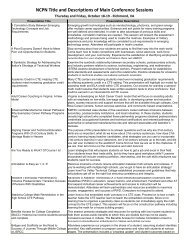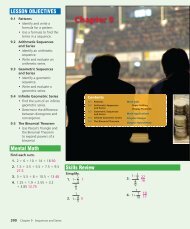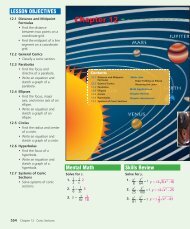Chapter 10 - NCPN
Chapter 10 - NCPN
Chapter 10 - NCPN
You also want an ePaper? Increase the reach of your titles
YUMPU automatically turns print PDFs into web optimized ePapers that Google loves.
As a paddle wheel spins on its axis, the height<br />
of a point on the wheel with respect to the<br />
water level can be modeled by the function<br />
h(t) = 15 – 18cos ≠t . The height above<br />
12<br />
or below the water is given in feet, and t is<br />
the amount of time in seconds. Answer the<br />
following questions to describe the paddle<br />
wheel as it spins on its axis.<br />
a. What is the diameter of the wheel<br />
b. How high above the surface of the water is<br />
the top of the wheel<br />
c. How long does it take the wheel to complete<br />
one full revolution<br />
Step 1 Understand the Problem<br />
Describe the problem situation in your own<br />
words. What information do you need to find<br />
Step 2 Develop a Plan<br />
Problem-solving strategy: Use a graph.<br />
What are suitable axis limits to graph the<br />
cosine function How will graphing the<br />
function help you answer the questions in<br />
the problem statement<br />
Step 3 Carry Out the Plan<br />
Graph the trigonometric function on a graphing<br />
calculator or on grid paper using suitable axes.<br />
Use the graph to find the diameter of the<br />
wheel, the maximum height above the surface<br />
of the water, and the amount of time it takes<br />
to complete a full revolution. Explain how you<br />
found your answers.<br />
Step 4 Check the Results<br />
Check your results to make sure they<br />
seem reasonable.<br />
Lesson Assessment<br />
Think and Discuss<br />
1. Explain how to solve the equation cos 2 θ – 1 = 0 for 0 ≤ θ < 180°.<br />
2. How many solutions are there to the equation 4 tan θ – 0.25 = 0<br />
Explain.<br />
3. If the sine of an angle is positive and one of the solutions in<br />
the interval 0 ≤ θ < 2π is known, how can the other solution<br />
be found<br />
4. How could a graphing calculator be used to find the solutions of<br />
a trigonometric equation within a particular domain<br />
488 <strong>Chapter</strong> <strong>10</strong> Trigonometric Functions and Identities











